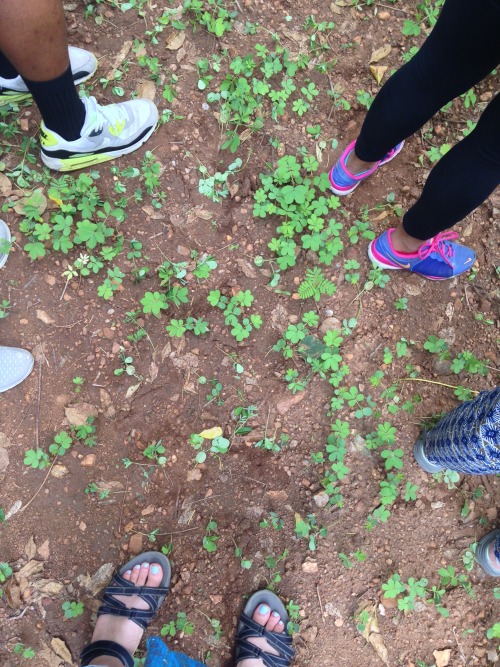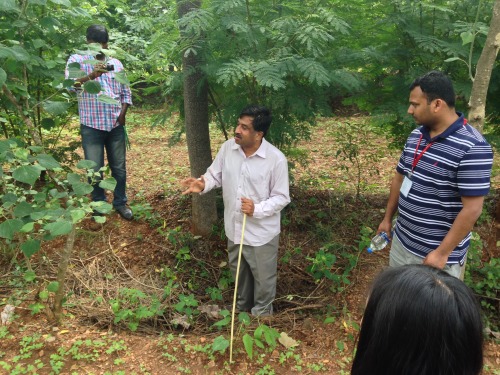
By Lindsey Bressler, International Affairs and Economics, Class of 2018
In the dark, well-air conditioned room on Dr. Sheshagiri Rao’s farm, the setting is perfect for falling asleep. The other members of our Dialogue and I have seen better days, physically speaking. We smell like sunscreen, bug spray and jars of prescription medication. We just survived a bumpy 3 hour bus ride from Bangalore to the state of Tamil Nadu. Nevertheless, we’re all awake and alert, ready to learn about sustainable agricultural profits during times of uncertainty.
I remember being here, in this very same room last year and being unable to engage. My brain and body were substantially weaker, the connections between agricultural process and the poor’s livelihoods less rigid in my mind.
So, when I look around at my classmates this – the healthy ones, the ones who were ready to come to this farm today – I feel renewed.
A few things to understand about Dr. Rao: he lives and raises his family in a village, trains students from IISc-Bangalore, loves interdisciplinary work, does academic research and owns an agricultural consulting company. Before we even stepped on the grounds of the farm, he tells us about the importance of rainwater.
“When there’s less rain, farmers get poor.”
The farm in Tamil Nadu does not look like it has seen the effects of a bad rain season. It looks like an oasis.

Back in the room where Dr. Rao gives us his presentation, he displays two photographs. One is the farm seven years ago. Trees are dead, the ground and air look brown. The second is the farm today: lush and unimaginably green. (Growing up in southern Arizona, I always get excited when I see green landscapes.)
Rain-based farming is inherently risky. India’s monsoons drive agricultural output, yet the climate variability involved means there are no profit guarantees. Dr. Rao, as a consultant, utilizes anticipatory design in order to account for this variability and tries to create other solutions for the farming poor.
He keeps repeating an impossible equation to us: 2+2=22.
What?
Again: 2+2=22.
Dr. Rao’s farm is, in a lot of ways, at the forefront of profit-maximization and innovation. We learn about his use of microbes instead of chemicals, which extract nitrogen from the air and create phosphorous and potassium through an acidic reaction process. He also explains the trenches that are on the farm, too. These trenches, adopted from a USDA technique, get filled up with biomass and later turn into extra-fertile planting ground after it rains.
In addition, Dr. Rao explains Common Sense Net, which he terms “Facebook for farmers.” Common Sense Net provides mobile advice for farmers and their problems, in any language they need. “The reason farmers don’t listen to scientists,” Dr. Rao says, “is that scientists give stupid advice. Scientists give stupid advice because customization is difficult.”
2+2=22 is, if anything, what this man lives for. The farm is a living example of how the sum is greater than its parts.
Out in the field, all of this means even more. As the group of us walks over the soil, our feet sink in to the ground. It’s that rich with nutrients. There are things that Dr. Rao says that I don’t completely fall in love with, especially when he focuses on profit-making. But the pride he has for his land is something seriously special.

While we all stand underneath the trees and look out into rows of farmland, the pride lifts itself from Dr. Rao’s work-calloused hands and onto our shoulders.
The pride travels over to our lunchtime meal, as the village chefs watch everyone enjoy their dal fry and chapatti and miniature bananas. Before we leave, we fold our hands in gratitude and clap for them – a thank you without words.
The pride follows us out of the kitchen and back onto the bus, where we continue to ask Dr. Rao questions. Questions like: “How many kinds of trees are there here?” “Can there be things that simply aren’t for profit?” “Why do you think it is more difficult to work with wealthy clients?”
Like Dr. Rao, I too am proud. Proud of beautiful land that is not my own, proud of thoughtful responses to challenging presentations, proud of the people who fight climate change from every angle.
I gather the remaining pride left over on our bus, hold it close to my heart, and say goodbye to Bangalore the next morning.
